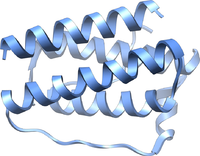
Photo from wikipedia
Abstract Background: In the inner ear, evidence has been gathered indicating that melatonin plays important roles in inner ear physiology and pathophysiology. However, no attempt has been made previously to… Click to show full abstract
Abstract Background: In the inner ear, evidence has been gathered indicating that melatonin plays important roles in inner ear physiology and pathophysiology. However, no attempt has been made previously to investigate the localization or expression of melatonin and its receptors in the whole inner ear. Aims/objectives: To analyze the presence of melatonin and its receptors in the normal mouse inner ear. Material and methods: C57BL6/J mice were used in this study. The localizations of melatonin, MT1a and MT1b in the inner ear, i.e. cochlea, vestibular end organs, vestibular ganglion and endolymphatic sac (ES), were studied by immunohistochemistry. Results: The organ of Corti, spiral ganglion, vestibular ganglion, vestibular sensory cells, vestibular dark and transitional cells, and ES epithelial cells showed an immunofluorescence reaction to melatonin, MT1a and MT1b. Conclusion and significance: The present findings show that melatonin and its receptors (MT1a and MT1b) are present in the inner ear, thus supporting the hypothesis that melatonin plays a physiological role in the inner ear.
Journal Title: Acta Oto-Laryngologica
Year Published: 2019
Link to full text (if available)
Share on Social Media: Sign Up to like & get
recommendations!